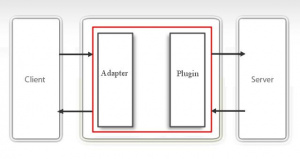Difference between revisions of "Paradigms of communication"
(→Synchronous-Asynchronous) |
(→Synchronous-Asynchronous) |
||
| Line 33: | Line 33: | ||
! !! Client !! GVESB Workflow Number !! Server | ! !! Client !! GVESB Workflow Number !! Server | ||
|- | |- | ||
| − | | Communication || Synchronous || 1 || | + | | Communication || Synchronous || 1 || Asynchronous |
|} | |} | ||
Revision as of 17:26, 10 February 2012
Contents
Description
Depending on the type of communication (Synchronous / Asynchronous), on the role played by GreenVulcano® ESB (active / passive) and on the response management, it is possible to have from a minimum of one to a maximum of four operations constituting a single interaction client - server.
GreenVulcano® ESB Configuration
GreenVulcano® ESB is configured for managing four paradigms of communication:
- Synchronous - Synchronous
- Synchronous - Asynchronous
- Asynchronous - Synchronous
- Asynchronous - Asynchronous
Synchronous-Synchronous
The Synchronous-Synchronous paradigm takes place following the Client -> GreenVulcano® ESB -> Server direction.
The following table shows its properties:
| Client | GVESB Workflow Number | Server | |
|---|---|---|---|
| Communication | Synchronous | 1 | Synchronous |
Synchronous-Asynchronous
The Synchronous-Asynchronous paradigm takes place following the Client -> GreenVulcano® ESB -> Server direction.
The following table shows its properties:
| Client | GVESB Workflow Number | Server | |
|---|---|---|---|
| Communication | Synchronous | 1 | Asynchronous |

